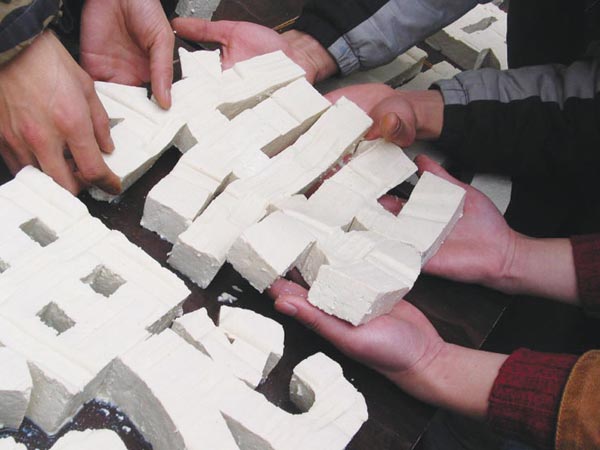
The Hundred Surnames in Tofu, an installation by Chen Qiulin, will be on display at the China Platform during Art Stage Singapore 2014. Photo Provided to China Daily
Singapore's leading art fair Art Stage Singapore returns in January with a special focus on Asia. The new fair format incorporates eight country and regional platforms, including China.
Launched in 2011,Art Stage Singapore has grown into a flagship art event that attracts the world's most influential art collectors and enthusiasts. The annual art fair has presented more than 100 galleries, of which 80 percent are Asia-Pacific-based ones, underscoring the fair's core Asian identity.
The fourth edition will be held from Jan 16-19 at Singapore's Mari-na Bay Sands Expo and Convention Center. Aside from conventional exhibitions, the newest edition will open about 1,800 square meters of space for eight country and regional platforms, which will be showcased in a museum-like exhibition layout to add a new dimension to the fair's artistic offerings.
"When we speak about Asia, we cannot speak about an undifferentiated, single Asian contemporary art scene as the region is highly segmented. However, there are few dialogues and limited understanding even among Asian countries themselves, "comments Art Stage Singapore founder and director Lorenzo Rudolf. "Through the platforms we mirror the dynamic and diverse art scenes across the region and bridge the disconnect and divide."
The Southeast Asia Platform-the largest among all-is curated by Art Stage Singapore itself in collaboration with six country advisers. Visitors will see about 25 newly commissioned projects from Singapore, Malaysia, Indonesia, Cambodia, Laos, Myanmar, the Philippines and Thailand.
The China Platform features nine galleries from areas including Beijing, Shanghai, Chengdu, Wuxi and Hong Kong, with each gallery high-lighting one Chinese artist.
"I display China Platform and its artworks according to its complexity and diversity," says China Platform curator Huang Du, an internationally known independent curator who has collaborated with numerous biennales.
"I prefer artworks with a unique sense and even beyond one's own imagination, as they can be proactive enough to create an immediate excitement. Thus, I very much like to explore and promote works that are rich in conceptual, experimental and avant-garde sense," Huang stresses.
Chinese artist Chen Qiulin, presented by A Thousand Plateau Art Space, will bring her installation work The Hundred Surnames in Tofu.
The artist uses tofu, a traditional Chinese food with a history of 2,000 years, to recreate the Chinese characters of the 100 Chinese family surnames, which also play an important historical role. The symbolic act draws together these two ancient traditions in a creative way.
Chinese artist Wang Guofeng, presented by De Sarthe Gallery in Hong Kong, will introduce his print work to explore the power of images and text.
In 2011,Wang was officially invited by the Democratic People's Republic of Korea to photograph the country's socialist architecture and in 2012,the 100th anniversary of Kim Il-sung's birth. The experiences gave birth to a new series of artworks.
Speaking of the contemporary art scene in the Asia-Pacific region by using China as an example, China Platform director Huang believes the new-generation artists' way of production and expression is transforming. "They emphasize the individualized language and the microcosmic method of art practice to demonstrate their force and strength," he says.
The Taiwan Platform has also taken a similar move. All four exhibited galleries there bring artists with art-works in new mediums, such as video and mixed media.
"Taiwan is known for its advancement in technology, which many artists are relying on," Taiwan Platform curator Rudy Tseng explains.
For example, artist Tu Wei-cheng, presented by Tina Keng Gallery in Taipei and Beijing, brings one of his mixed-media installations named The Emperor's Treasure Chest-Two.
The Emperor's Chest is a series of antique-like screening machines made by Tu. He incorporates old film and animation techniques, such as shadow puppets, kaleidoscopes and magic lantern slides, and transforms them to create a theatrical display of modern scenes of cities and inhabitants.
"We are today in a time that the two directions-the market and the academic part-are going further a way from each other. But if we want to introduce an artwork, we have to introduce more than only a price to truly understand the art-work. That's why we must bring the market and the content together, and that's exactly what we try to achieve through these platforms," concludes Rudolf, the founder and director of Art Stage Singapore.
We recommend:
